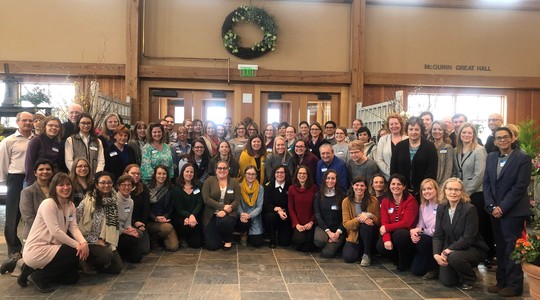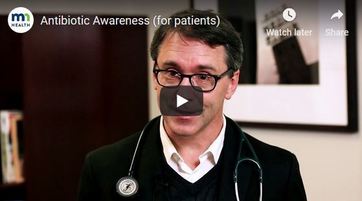
What percent of Minnesotans with blastomycosis were prescribed three or more antibiotics prior to diagnosis of this fungal infection?
A. 5%
B. 25%
C. 45%
D. 65%
|
The answer is at the bottom of this newsletter.
|
|
Minnesota One Health Antibiotic Stewardship Collaborative Annual Meeting
The Minnesota One Health Antibiotic Stewardship Collaborative joined together on February 5, to discuss 2018 progress and to chart the course for 2019. Look for the summary of the meeting and our 2018 activities in the next email bulletin.
Thank you to the outgoing 2018 work group Chairs!
-
Jennifer Granick, DVM, PhD, University of Minnesota College of Veterinary Medicine, Chair of the Animal Stewardship Work Group
-
Edwin Pereira, MD, Saint Paul Infectious Disease Associates, Chair of the Health Care Stewardship Work Group
-
Nancy Rice, MPH, Minnesota Department of Health, Chair of the One Health Engagement Work Group
-
Rebecca Zadroga, MD, Hennepin Healthcare, Chair of the Antibiotic Footprint Work Group

Physician Interview Informs New Awareness Videos
- Members of the Minnesota One Health Antibiotic Stewardship Collaborative interviewed Dr. Jon Hallberg, a family medicine physician and Medical Director of the University of Minnesota Physicians Mill City Clinic, on film.
- These informational videos concisely answer questions about antibiotic resistance, appropriate antibiotic use, proper medication disposal, and more.
- Videos are designed for clinicians and patients. In addition to the audio, they are captioned and can be used in waiting and examination rooms, on clinic webpages, patient portals, and in social media.
- Watch the videos on the MDH YouTube Playlist: Antibiotic Awareness Videos and consider using them in your stewardship work.
- To download to patient-focused video, copy and paste this link ftp://mdh-ftp.health.state.mn.us/pub/Downloads/ in your browser and click download.
- Dr. Hallberg is a regular on Minnesota Public Radio (MPR) “House Calls.” Listen to him talk about antibiotic use and resistance at MPR, Medical practitioners taking closer look at how they use antibiotics.
 |
Now Available: Bundle your cold and flu resource materials
- Utilize these helpful resources for patients with viral infections. Find the materials by using these Minnesota Department of Health website links.
- If you think other materials would be helpful in educating patients about proper antibiotic use, please send your ideas to health.stewardship@state.mn.us.
Now Available: Waiting room educational resources
- Prevent boredom and raise antibiotic awareness at the same time! Use fun resources in examination and waiting rooms to inform pediatric and adult patients about antibiotic resistance and stewardship.
- Find the materials by using these Minnesota Department of Health website links.
Annual Report: Healthcare-associated infections in acute care hospitals
MDH Website Links Recently Updated
- Minnesota Department of Health (MDH) updated websites on Feb. 14. Please plan accordingly and update your bookmarks or resources with these hyperlinks.
|
|

Study Shows Duration of Antibiotic Prescriptions is an Important Target for Stewardship
Reductions in Total Antibiotics Fluoroquinolone Use, and Late Generation Cephalosporin Use Associated with Decreased Rates of Hospoital-Onset C. difficile
Penicillin Skin Testing Associated with Antibiotic De-Escalation
Cat Owner Perceptions of Antibiotic Use Measured in the United Kingdom
- In a new Journal of Feline Medicine and Surgery article, researchers describe a high cat owner awareness that antibiotics are effective on bacterial, rather than viral, infections and that antibiotic resistance could be a problem for cats.
- This work also highlights a previously known target for antibiotic stewardship in small animal medicine--the need for improved diagnostic testing associated with antibiotic prescribing. Most owners reported a willingness to pay for diagnostic testing, if the veterinarian thought it needed, although only 39% of respondents recalled their cats having any diagnostic testing prior to antibiotic prescription.
- Client perceptions must be understood if we are to change behaviors and advance antibiotic stewardship in small animal medicine.
- Read the abstract: Sage Journals, A UK-based survey of cat owners’ perceptions and experiences of antibiotic usage
Two Reports Highlight Reduction in Antibiotic Use for Food Animals
In the Food and Drug Administration 2017 Summary Report On Antimicrobials Sold or Distributed for Use in Food-Producing Animals, data show that all antimicrobials sold or distributed for use in U.S. food-producing animals have declined for past two years.
- The decrease was 33% during 2016–2017 and 43% since 2015.
-
Declines reflect U.S. market changes in place since in January 2017, medically important antibiotics used in feed and water came under veterinary oversight and all growth promotion claims were removed.
Also, World Organization for Animal Health (OIE), Annual Report on Antimicrobial Agents Intended for Use in Animals reports a global reduction in antibiotic use for growth promotion in food animals
-
71% (110/155) of responding countries did not use antimicrobial agents for growth promotion in animals as of 2017.
-
Of the 45 countries reporting use of antimicrobials for growth promotion, 18 (40%) had regulatory framework listing antimicrobials that could or could not be used for growth promotion.
University of Minnesota Shows Record of Historical Antibiotic Use in Lake Sediment
- Researchers quantified accumulation of antibiotics used in health care and animal health over decades in Minnesota lake-sediment.
- Antibiotic presence in the sediment core layers was consistent with initial dates of Food and Drug Administration approval and subsequent clinical use.
- Wastewater effluent appeared to be the primary source of antibiotics in the studied lakes, with lesser inputs from agricultural activities.
- Read the article abstract: ScienceDirect, Sedimentary Record of Antibiotic Accumulation in Minnesota Lakes.
- Authors of this study are engaged in Minnesota One Health Antibiotic Stewardship Collaborative's state-funded project to map the antibiotic footprint of Minnesota's natural environment (LCCMR, Environment and Natural Resources Trust Fund Work Plan).

Veterinary Antibiotic Stewardship Webinar Series, Hosted by MOHASC and MVMA
-
What: Five-part webinar series for veterinarians with continuing education credit, hosted by Minnesota One Health Antibiotic Stewardship Collaborative and Minnesota Veterinary Medical Association
-
Who: Open to and free of cost to all
-
When: One day each month during April-August. Stay tuned for dates and times.
-
April: Realities of Antibiotic Resistance and Stewardship in Small Animal Practice
Jennifer Granick, DVM, PhD, University of Minnesota
-
May: Use of Peer-Reviewed Treatment Guidelines to Improve Prescribing in Small Animal Medicine
Scott Weese, DVM, DVSc, Ontario Veterinary College
-
June: Antibiotic Stewardship in Production Animal Medicine: Regulations and Practice
Mike Apley, DVM, PhD, Kansas State University
-
July: Antibiotics in the Environment: What do we know, and what is the veterinary role?
Irene Bueno-Padilla, DVM, PhD, University of Minnesota
-
August: Antibiotic Stewardship and Prescribing in Equine Practice
Wendy Vaala, VMD, Merck Animal Health
-
Registration: Register for the April webinar on the MVMA, Veterinary Antibiotic Stewardship Webinar Series website.
Save the Date: 2019 Antibiotic Stewardship Continuing Education Conference
This year, the focus of this full-day conference is on patient and provider stewardship education. Join us for a day of free continuing education and conversation with national and local experts, as well many fellow Minnesota stewardship practitioners.
-
When: May 13, 2019
-
Who: Relevant for prescribers, clinical staff, and pharmacists in hospitals, long-term care facilities, outpatient clinics, emergency departments, and dental clinics. Administrators and those involved in patient engagement and education and quality improvement are also welcome to attend.
-
Where: Wilder Center, 451 Lexington Avenue North, St. Paul, MN 55104
-
Registration: Registration details will be available soon.
Free Pharmacist Continuing Education: Outsmarting Multi-Drug Resistance in Uncertain Times
World Health Organization Presents a Competency-Based Course on Antimicrobial Stewardship
- This course is meant to equip clinicians who frequently prescribe antimicrobials with knowledge and tools essential to improving their daily practice.
- Participants will understand core competencies of antimicrobial stewardship and how they can be applied to common clinical scenarios.
- Register for the course at WHO, Antimicrobial Stewardship: A competency-based approach.
|
|

C. 45%
Blastomycosis is a rare fungal infection in humans and animals, usually acquired by inhalation of Blastomyces dermatitidis fungal spores, which can be present in wood and soil. Antibiotic treatment is not effective for fungal infections. Blastomycosis is a reportable disease in Minnesota. All people with blastomycosis are interviewed by Minnesota Department of Health (MDH) staff to understand individual situations that might have led to infection. Interviews also provide information on illness and treatment course. MDH has found that 45% of human patients were prescribed three or more antibiotics prior to their blastomycosis diagnosis. Find more information on this disease on the MDH blastomycosis webpage.
|
|
|
|
|